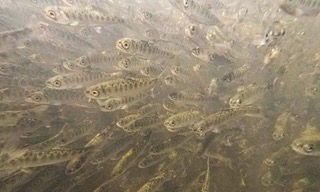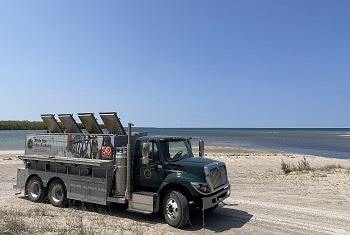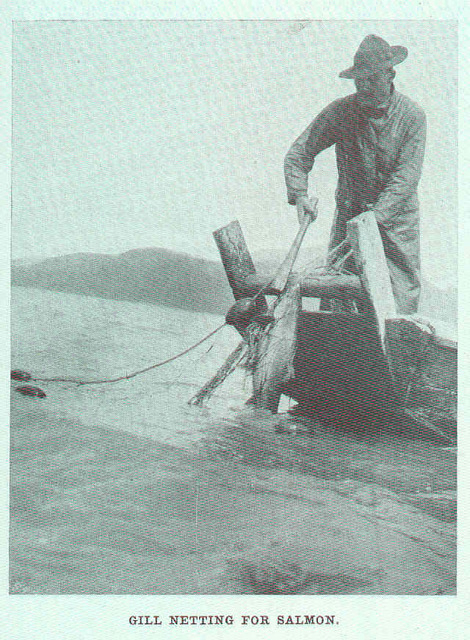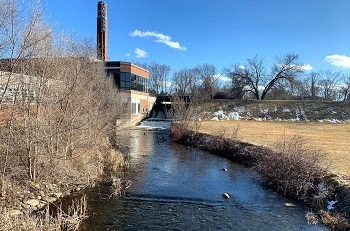Dam Removal Rehabilitates Michigan Streams

With the crisp chill of autumn in the air, they made their way north. Negotiating obstacles along their way, these hearty, determined travelers normally would be stopped at the old dam on Thompson Creek – but not today.For the first time in more than half a century, Chinook salmon were able to reach graveled spawning areas upstream of the dam.
This historic event occurred thanks to a recent cooperative project to remove two old dams, which were associated with the Thompson State Fish Hatchery, along Williams and Thompson creeks in Schoolcraft County.
Michigan Department of Natural Resources fisheries biologists, who had been hoping for this outcome, were thrilled.
Chinook salmon are shown swimming over the gravel bottom of Williams Creek in autumn 2015, the result of a dam removal and stream restoration project.”Salmon and steelhead have returned to the creek,” said Jan VanAmberg, manager of the Thompson and Marquette state fish hatcheries. “It was the first time salmon had ever had access to the creek since the dams were built prior to the Great Lakes salmon program.”
Over the past few years, the DNR has increasingly been working to help remove obsolete dams and restore natural stream conditions through several projects across the state.
In 2015, the DNR Fisheries Division provided technical assistance on 12 dam removals and four improved road stream crossings that resulted in more than 73 miles of reconnected aquatic habitat.
“These efforts not only reconnect and rehabilitate aquatic habitat, but also often result in improved and self-sustaining fish communities,” said Jessica Mistak, supervisor of the Habitat Management Unit of the DNR Fisheries Division.
In 1922, the Thompson State Fish Hatchery was constructed not far off M-149, about 8 miles west of Manistique.
Two years later, the Williams Creek Dam was built. Water from the impoundment flowed into the raceways at the hatchery and then to Thompson Creek. The structural height of the dam was 10.5 feet.
In 1944, the 6-foot-tall Thompson Creek Dam was erected on the fish hatchery grounds. Like the Williams Creek Dam, this dam had stop logs as part of the construction.
In 1978, the DNR built a new Thompson fish hatchery closer to a natural spring. The new complex was situatedA colorful postcard, circa 1950, shows the former Thompson State Fish Hatchery west of Manistique. about a mile upstream from the original location. Reliance on the high-quality spring as a water source for the hatchery made the creek dams no longer necessary. Water at the hatchery from the enclosed spring is combined with shallow cold well water and deep geothermally heated well water.
Blending of the three water sources gives biologists and technicians temperatures they desire for fish production. Total water flow at the hatchery is 4.3 million gallons per day.
Because of its new unique water supply, the Thompson facility can produce a wide range of fish species for stocking in inland and Great Lakes waters.
For example, from October 2012 through September 2013, the hatchery produced and stocked a total of 4.4 million fish, including brown trout, steelhead, Chinook salmon and walleye.
In 1995, an effluent treatment pond at the hatchery was upgraded in another major renovation project. The stop log bay on the Williams Creek Dam was opened in 2003.
Last summer, the DNR parks and recreation and fisheries divisions worked cooperatively to remove piping, dam and hatchery structures that had remained in place after the Thompson hatchery was moved to its new location in 1978.
In 2014, a $60,900 DNR Aquatic Habitat Management grant was awarded to the project to remove the remaining dams and restore Thompson and Williams creeks.
A backhoe works to remove portions of the Williams Creek Dam in summer 2015.The Aquatic Habitat Management grant program began in October 2013 and will continue to operate each year funding is available. In 2015, about $1.2 million was available for these grants from the Game and Fish Protection Fund.
Projects funded under the grant program emphasize rehabilitation of degraded aquatic resources, development of self-sustaining aquatic communities that provide for continuing recreational opportunities and natural resource-based economies and development of strong relationships, and partnerships and new expertise related to aquatic habitat protection and recovery.
The grant program provides money for work involving streams, rivers, inland lakes or the Great Lakes.
Past Aquatic Habitat Management grant awards have ranged from a $25,000 grant for the Ocqueoc River Grist Mill abutment removal in Presque Isle County to a $300,000 grant to restore the Grand River at Lyons in Ionia County.
Beyond the DNR, partners in the Thompson project included the Michigan Department of Environmental Quality and the Schoolcraft County Sport Fishing Association.
“In addition to a financial contribution, the association generously donated time,” said Randy Espinoza, biologist at the Thompson hatchery, in a thank-you letter. “These man hours put in by the association, working side by side with DNR staff, were very valuable. This teamwork is what helped make this project a success.”
The initial phase of the Thompson project was to remove the Thompson Creek Dam, followed by removal of the Williams Creek Dam. The lower portion of Williams Creek was then reshaped with backhoes and other equipment.
“All of the work done on Williams Creek was from the dam through the last roughly 300 feet before it enteredWorkers shape the channel in the upper section of the Williams Creek stream rehabilitation project. Thompson Creek,” Mistak said. “Within the first 100 feet or so, the existing channel was reshaped.”
A new stream channel was dug in the last approximately 200 feet (this portion of the creek was flowing through old raceways prior to the new channel) to improve the aquatic habitat in Williams Creek.
“Additional work has since been done,” VanAmberg said. “The new stream banks have been vegetated with new grass and the staff here has transplanted numerous trees to stabilize the banks over time.”
A new interpretive sign will be installed this spring once the ground thaws.
“The new reconstructed stream has experienced several flood events over last fall and this spring and the banks have held up well,” VanAmberg said.
The interpretive sign said removing the dams allows for aquatic organism passage and restored connectivity, as well as cooler water temperatures and higher oxygen levels on about 7 miles of stream, extending north from Lake Michigan to the upper reaches of the two creeks.
In addition to the Aquatic Habitat Management grant program, grant funding for dam repair and removal projects is also available through the DNR’s Dam Management grant program.
The reconstructed Williams Creek channel winds through a grassy field. Salmon and steelhead have returned to the creek for the first time in decades.Projects funded under this program help remove obsolete structures or repair functioning dams, resulting in improved fisheries, aquatic resources and public safety.
In late 2012, the grant program was initiated supporting Gov. Rick Snyder’s infrastructure initiative. State general fund money is appropriated by the Michigan Legislature to fund the grants.
For more information on the DNR’s Aquatic Habitat Grant Program or the Dam Management Grant Program and others, visit www.michigan.gov/dnr-grants.
Check out the work of the DNR’s Thompson fish hatchery, including a video provided by “Discovering” television host Brian Whitens.
The grounds at the Thompson State Fish Hatchery – one of six in Michigan – are open daily with no admission cost. A visitor center is open from 7:30 a.m. to 3:30 p.m. For more information, call 906-341-5587, ext 201.
For more information on fishing in Michigan, visit the DNR’s webpage at www.michigan.gov/fishing.






